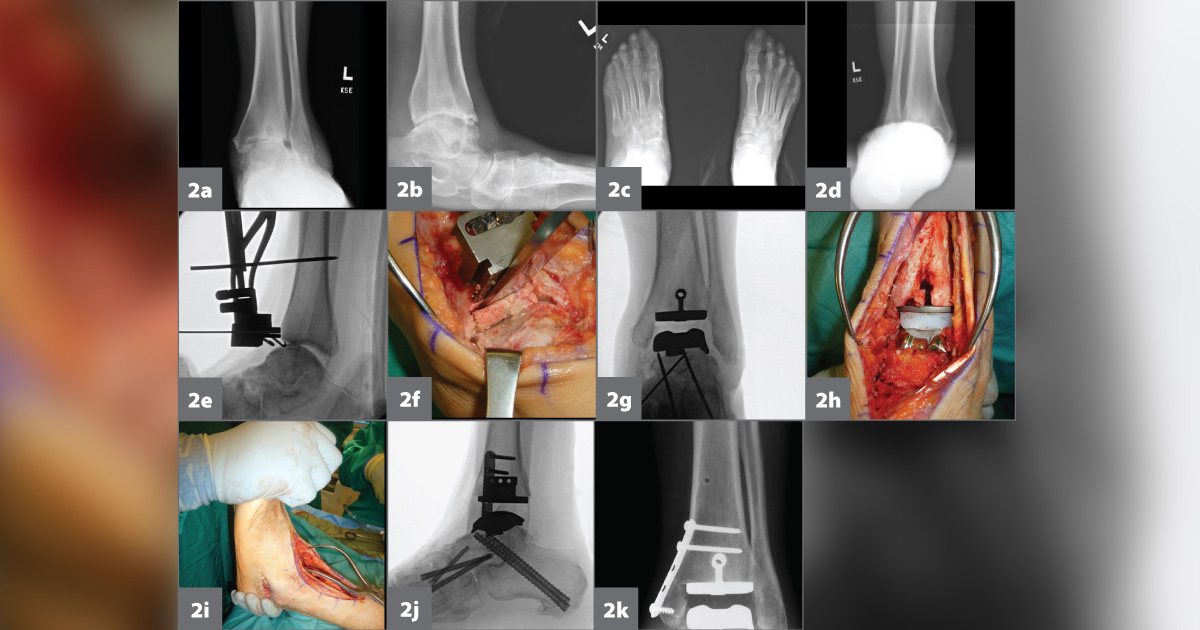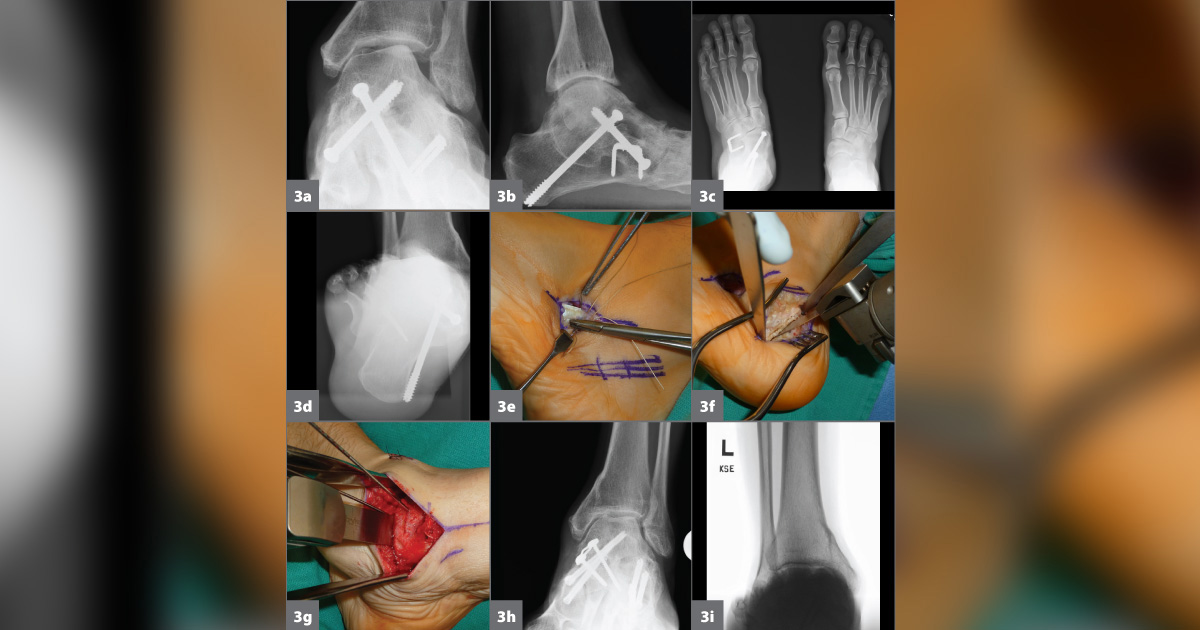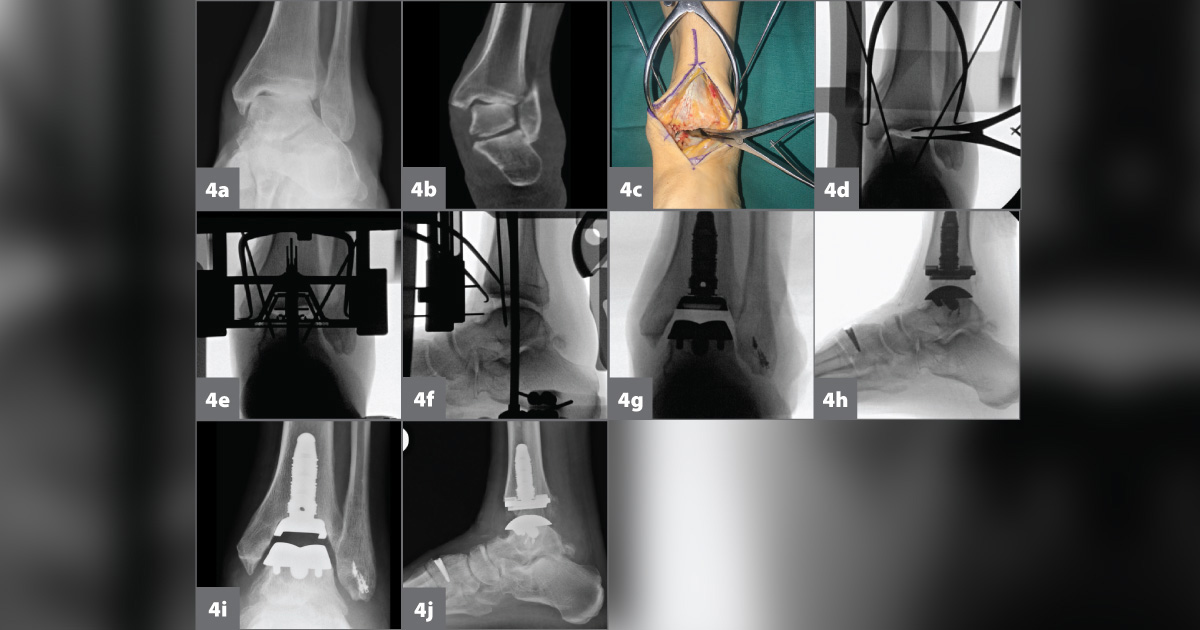Apply basic orthopedic principles to TAA in stage 4 acquired flatfoot deformity
Through modern implants and improved surgical techniques, surgeons are able to achieve improved outcomes with total ankle arthroplasty, including in patients with increasing levels of foot and ankle deformity.
Initial expert opinion suggested that total ankle arthroplasty (TAA) in the setting of 15° or more of coronal plane malalignment is contraindicated. More recently, longer term outcomes of TAA in ankles with deformities greater than 15° are promising, provided attention is placed on the optimal soft-tissue balancing of the ankle and re-establishing a stable platform to support the ankle, as discussed in studies by Constantine A. Demetracopoulos, MD and colleagues (2019) and by Gun-Woo Lee, MD, PhD (2018 and 2019) (Figure 1). Compared with moderate deformities, severe ones more consistently require additional procedures at a rate of about two to one according to Demetracopoulos and colleagues. The investigators elucidated a subset of the valgus arthritic ankle that can be particularly challenging to treat. Among 80 patients they included with greater than 10° valgus coronal malalignment, 26 patients had an associated flatfoot deformity (33%).


The focus of this article is TAA in patients with stage 4 flatfoot deformity. In 1997, Mark S. Myerson, MD, added stage 4 acquired flatfoot deformity to the 1989 posterior tibial tendon deficiency/adult acquired flatfoot deformity grading system of Ken E. Johnson, MD. Stage 4 is adult acquired flatfoot deformity with valgus ankle talar tilt, suggesting deltoid ligament attenuation (Figure 2) Video. Many authors have described various techniques to reconstruct the deltoid ligament in the absence of ankle arthritis; solutions successfully addressing this pathology in combination with TAA remain incompletely defined.

Source: Mark E. Easley, MD, FAAOS
Although several authors focus their recommendations for surgical correction of the valgus ankle arthritis with stage 4 flatfoot deformity on medial ankle ligament reconstruction, we favor applying the generally accepted orthopedic principles used by adult reconstructive/arthroplasty surgeons. In general, even the severely valgus arthritic knee is rarely, if ever, treated with medial soft tissue reconstruction. Perhaps a more constrained prosthesis may be warranted, but medial collateral ligament reconstruction is rarely performed. In our opinion, in treating valgus ankle arthritis associated with the stage 4 flatfoot, we should “wear our orthopedic hats” when correcting coronal plane deformity. In the majority of cases, proper bony cuts and minimal bony resection allows the properly aligned implant and polyethylene insert to optimize balance of the residual soft tissue structures, including the attenuated deltoid ligament. Re-establishing physiologic mechanical axis alignment is important in both valgus ankle and knee arthritis, with both joints requiring a stable foundation on which to rest. Whereas well-aligned and/or constrained total knee arthroplasty may function well with some residual foot deformity, TAA typically does not. Valgus talar tilt may be corrected without TAA by re-establishing foot alignment and balance even without deltoid ligament reconstruction (Figure 3).

The interdependence of the ankle and hindfoot articulations often allows for remarkable hindfoot correction with TAA alone. However, in stage 4 flatfoot deformity, adjunctive procedures to re-establish anatomic foot realignment with a stable hindfoot and a medial column are generally required. TAA implants, when properly implanted, function to realign the ankle-hindfoot complex and may even tighten the peroneus longus tendon, with its insertion at the base of the first metatarsal, to provide greater dynamic medial column support. However, stabilization of the medial column with osteotomies or arthrodesis is often required.

We do not suggest that medial ligament reconstruction is never required, but, as in valgus knee arthritis, we do not believe it is the focus of correcting alignment in valgus ankle arthritis. Furthermore, we hypothesize that in the arthritic process matrix metalloproteases in conjunction with Interleukin-1, Interleukin-6 and TNF alpha lead to capsular thickening through scar formation. This thickening leads to residual soft tissue constraint, especially on the medial side where the deep deltoid is confluent with the capsule. Through proper and minimal bone resection, soft tissue balance may be re-established with TAA in a majority of cases without deltoid reconstruction.
Surgical technique highlights
Concerning valgus ankle arthritis and stage 4 flatfoot deformity, in addition to standard weight-bearing ankle radiographs, preoperative planning includes weight-bearing CT, long leg films, assessment of tibial deformity and referencing of the tibial shaft and a perpendicular line to the lateral joint. To correct valgus talar tilt, we plan a coronal plane tibial cut perpendicular to the longitudinal axis of the tibia; in general, we plan an anatomic talar dome cut, but may favor slightly greater resection of the medial talar dome, especially if there is lateral dome wear.

Valgus knee arthritis typically requires lateral soft tissue release performed directly at the lateral capsule; in the ankle, the lateral release is generally accomplished by passing an elevator plantarly through the ankle’s lateral gutter to release contractures. When performing independent tibial and talar cuts, we minimize bone resection to less than recommended in the surgical technique for ankles without deformity, particularly on the tibia as per the example in Figure 2. When using a monoblock (coupled) cutting guide for both the initial tibial and talar preparations, we place a lamina spreader in the lateral aspect of the joint to correct valgus deformity and to distract the ankle so that tibial and talar resections will be minimized. To maintain correction and joint distraction created through releases and use of the lamina spreader, the talus may be provisionally pinned in a neutral or even slight varus position (Figure 4) Video Video.
Perhaps the greatest lesson we have learned is that due to interactions in the ankle-hindfoot complex, proper ankle correction often affords considerable foot correction. Just like gap balancing in TKA, following the initial bone resection, use of spacer blocks confirms satisfactory bony alignment and provides a preliminary understanding of coronal plane soft tissue balance. The general orthopedic principle of “working from proximal to distal” may reduce the extent to which the foot may need to be realigned. Moreover, an article in 2020 by Brandt C. Buckner, MD, and colleagues confirms how varus ankle realignment increases loading of the lateral foot while decreasing medial column loading. In our experience, unless the foot can be positioned perfectly, starting distally with flatfoot correction, especially with arthrodesis, it may lead to suboptimal and eccentric foot loading after staged TAA.

With the final balanced TAA components in place and foot alignment improved through TAA alone, the need for additional foot procedures may be assessed. Anecdotally, without first re-establishing ankle alignment and balance, we tend to perform more foot procedures than may be necessary. In the series by Demetracopoulos and colleagues, the most common associated procedures among 26 patients were Achilles tendon lengthening or gastrocnemius recession in eight patients, Cotton or first tarsometatarsal arthrodesis in six patients and medializing calcaneal osteotomy in four patients. None of these patients underwent deltoid ligament repair.
In severe cases, hindfoot arthrodesis and even extension of the arthrodesis to the medial column may need to be performed. In addition to creating optimal ankle balance, we emphasize re-establishing a stable platform to support the ankle rather than expecting the medial soft tissue reconstruction to adequately support the ankle (Figure 5). In the rare case in which the ankle remains unstable despite proper ankle and foot realignment, we then consider reconstituting the deltoid ligament.
Conclusion
When performing TAA for valgus ankle arthritis associated with stage 4 ankle arthritis, we do not suggest that deltoid repair is never necessary. However, based on our experience, we caution against depending on medial soft tissue reconstruction as a primary stabilizer to correct this deformity.
- References:
- Buckner BC, et al. Clin Orthop Relat Res. 2020; doi:10.1097/CORR.0000000000001294.
- Demetracopoulos CA, et al. Foot Ankle Spec. 2019;doi:10.1177/1938640018785953.
- Johnson KA, et al. Clin Orthop Relat Res. 1989;239:196-206.
- Hintermann B, et al. Foot Ankle Clin. 2019;doi:10.1016/j.fcl.2019.02.005.
- Lee GW, et al. J Bone Joint Surg Am. 2018;doi:10.2106/JBJS.17.00703.
- Lee GW, et al. J Bone Joint Surg Am. 2019;doi:10.2106/JBJS.19.00416.
- Myerson MS. Instr Course Lect. 1997;46:393-405.
- Steginsky B, et al. Foot Ankle Clin. 2019;doi:10.1016/j.fcl.2019.02.012.
- For more information:
- Fernando A. Aran, MD, is a fellow in the Duke Foot and Ankle Division; and Mark E. Easley, MD, FAAOS, is chief of the Duke Foot and Ankle Division, 4709 Creekstone Drive, Durham, NC 27703. Aran’s email: fernando.aran@duke.edu. Easley’s email: mark.e.easley@duke.edu.






